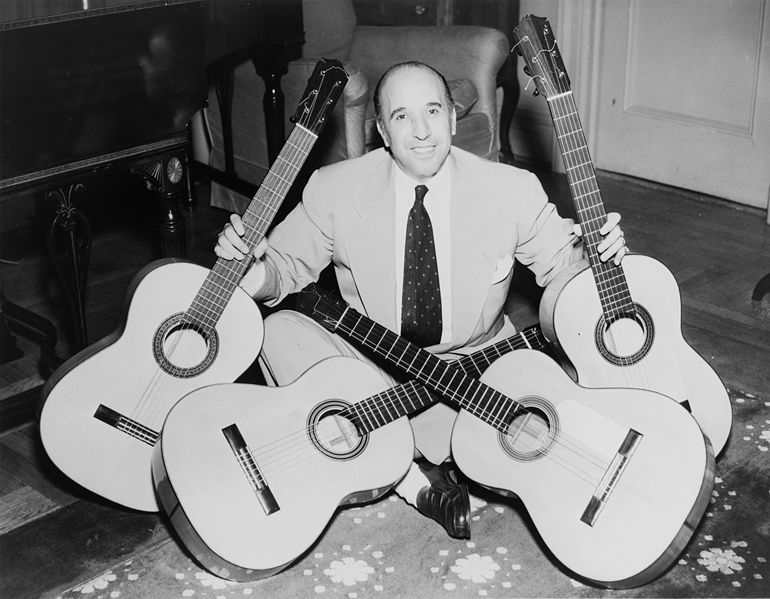<Back to Index>
- Composer Luis Maravilla (Luis Lopez Tejera), 1914
- Guitarist Pepe Martínez, 1923
- Guitarist Carlos Montoya, 1903
PAGE SPONSOR

Luis Maravilla (Luis Lopez Tejera) (1 June 1914 – 2000) was a Flamenco composer. He was born in Seville, Spain.
Maravilla studied guitar under Marcelo Molina and Pepe de Badajoz, and debuted professionally at the age of 12 in the Pavon Theatre of Seville. In the 1930's he toured much of North and South America. The Spanish Civil War brought him to France. Returning to Spain in 1940, he performed with such troupes as Gracia de Triana and Estrellita Castro. Maravilla retired in 1957 to begin teaching.

Pepe Martínez (1923-1984) was a Spanish flamenco guitarist born into a musical family, in the Seville quarter of Macarena. His mother, Isabel, was famous for her singing of religiously inspired Saetas, a vocal style which has since been incorporated into the flamenco palo.
Pepe was a virtuoso exponent of 'Flamenco Lírico', a style of playing which emphasizes the melodic as well as rhythmic elements of flamenco. His musical style reflected his warm personality. His playing, even more than many other flamenco guitarists of the time, was strongly influenced by that of his mentor, Ramón Montoya.
Pepe initially excelled in accompanying the Cante and Baile before developing a solo concert career. As an accompanist he played with such artists as Pepe Marchena, Niña de los Peines, Pepe Pinto, Juanito Valderrama, Niña de la Puebla, Niña de Antequera, Pepe Aznalcollar, Pepe Guillena, Niño de la Huerta amongst others.
Pepe was cited by Carlos Montoya, in the New York Guitar Review, as being one of the very finest flamenco guitarists of his generation along with Manolo de Huelva, Sabicas, Mario Escudero and Niño Ricardo.
Pepe Martínez made many recordings throughout his career, in Spain, France and the UK, on Columbia, Belter, Discophone, HMV, Odeon, Hispavox, Decca, Odean, Guilde Internationale du Disque and Discophon.
The BBC made a documentary on his life ("My Friend Pepe Martinez") as part of a series about the spirit of Spain. Pepe also featured, along with Andres Segovia, in a French television film titled Sortileges du Flamenco.
During his career, Martínez played guitars by Archangel Fernandez, Marcelo Barbero and Manuel Reyes. It was Pepe Martínez who introduced the young Manuel Reyes to the workshop of Marcelo Barbero.
His pupil, Prof. Malcolm Weller, of the Spanish Guitar Centre, owns his Barbero guitar.


Carlos Montoya (13 December 1903 – 3 March 1993) was a prominent Flamenco guitarist and a founder of the modern day popular Flamenco style of music.
His
unique style and successful career, despite all odds, have left a great
legacy for modern day Flamenco. It is because of his pioneering work in
popular Flamenco music that have allowed other great modern groups such
as the Gipsy Kings to take hold in all parts of the world.
Carlos Montoya was born in Madrid, Spain, into a Romani family, on December 13, 1903. As the nephew of renowned flamenco guitarist Ramón Montoya he seemed to have been born to play Flamenco, but it was his uncle who would be his biggest obstacle, as he refused to teach Carlos the tricks of the trade. He began studying the guitar with his mother and a neighboring barber, Pepe el Barbero, a.k.a. Pepe the Barber. By the time he was 14 years old he was accompanying dancers and singers in the cafes of Madrid, Spain.
In the 1920s and 1930s he performed extensively in Europe, North America, and Asia with the likes of La Teresina. The outbreak of World War II brought him to the United States where he began his most successful days as a musician, and frequently toured with the dancer La Argentina. Settling in New York City during World War II (circa 1941), he began touring on his own, bringing his fiery style to concert halls, universities, and orchestras. During this period he made a few recordings for several major and independent labels including RCA Victor, Everest and Folkways.
Montoya toured year round but always returned to his homeland, Spain, to spend the Christmas holidays with his family.
His style was not particularly appreciated by serious flamenco students, who considered it less brilliant than many others, including that of Montoya's uncle Ramón. Carlos's own favorite flamenco guitarist, it was reported by Zern, was the obscure Currito de la Geroma. That he was unpopular among aficionados owes largely to the fact that Montoya learned in a non - traditional way and that he abandoned the compás which has evolved within flamenco over hundreds of years. Many of his works do not even keep perfect tempo, increasing and decreasing in speed almost whimsically. He was admired for the speed of his picados and undoubtedly found popularity on the international stage as a result of this technically impressive pace. However, Montoya's playing is often criticized by flamenco traditionalists for having more flash than musical substance. He was known to play with a capo on the 3rd fret and on really loose strings. It is suspected he tuned down and then compensated with the capo to increase his ability to apply picado.
Montoya died on March 3, 1993 at the age of 89 of heart failure in the tiny Long Island, New York, town of Wainscott, New York.